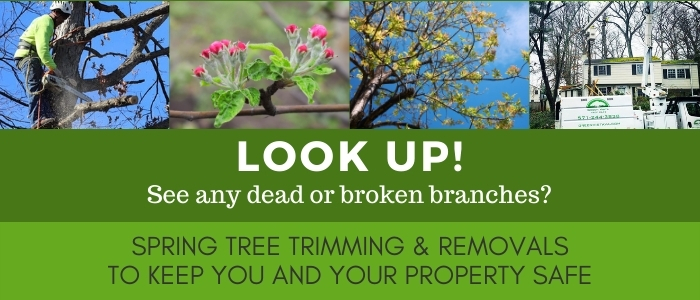
Top Five Landscape Trees for Fall Color in Northern Virginia

Many people associate fall with the changing color of tree leaves – over the space of a few weeks the whole landscape seems to magically morph from green to brilliant shades of orange, gold, red, and purple.
We often get asked for recommendations on the best trees to plant in Northern Virginia for stunning fall color. Everyone has their favorites, including us! So we’ve put together this list of the best landscape trees for fall color in our part of Northern Virginia.
Our favorites are well-adapted native trees and are sure to perform beautifully in our area. Some, such as maples and scarlet oak, are ones you typically think of as having great fall color. But there are other terrific trees that turn gorgeous shades of yellow in fall and would also make a good addition to your yard. Keep reading for details!
Red Maple (Acer rubrum)
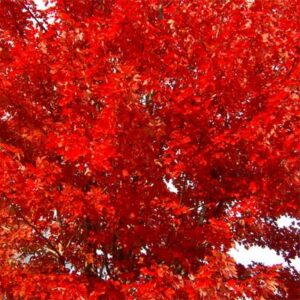 The red maple grows up to 90 feet tall (that’s tall!) with a rounded shape. It’s an attractive tree in summer but hits its stride in autumn when the leaves turn brilliant scarlet, orange or yellow. Red maple is a popular shade and ornamental tree (but give it room to grow) and tolerates the widest variety of soil conditions of any North American forest species.
The red maple grows up to 90 feet tall (that’s tall!) with a rounded shape. It’s an attractive tree in summer but hits its stride in autumn when the leaves turn brilliant scarlet, orange or yellow. Red maple is a popular shade and ornamental tree (but give it room to grow) and tolerates the widest variety of soil conditions of any North American forest species.
If you’re looking for something similar with a smaller size, try the Freeman maple (Acer x freemanii). This outstanding landscape tree is a hybrid of the red and silver maples. The adaptable trees reach 40-60 feet and have pyramidal crowns. For consistently outstanding fall leaf color, try the remarkably hardy Autumn Fantasy®, which develops deep burgundy leaves in autumn. The popular Autumn Blaze® is another great choice coveted for its consistent scarlet-red fall color and exceptional drought tolerance.
Scarlet Oak (Quercus coccinea) and Pin Oak (Quercus palustris)
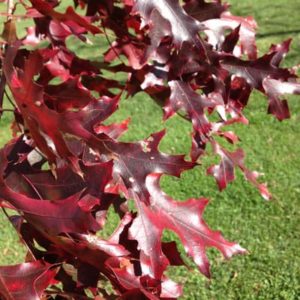 We have a ton of native oaks here in northern Virginia, but the leaves on most of them simply turn brownish in autumn. But the leaves of two of our native oaks, the Scarlet Oak and the Pin Oak are some of the most colorful contributors to the fall foliage display, turning bright red before falling.
We have a ton of native oaks here in northern Virginia, but the leaves on most of them simply turn brownish in autumn. But the leaves of two of our native oaks, the Scarlet Oak and the Pin Oak are some of the most colorful contributors to the fall foliage display, turning bright red before falling.
Both are surprisingly fast-growing oaks for the landscape that can reach 50 to 80 feet at maturity and offer exceptional red fall color. Plant them in a spacious open spot where they can reach their full potential. The Scarlet Oak prefers well-drained to dry soil and is drought tolerant, while the Pin Oak prefers poorly-drained soil and is tolerant of a wide range of urban stresses.
Shagbark Hickory (Carya ovata)
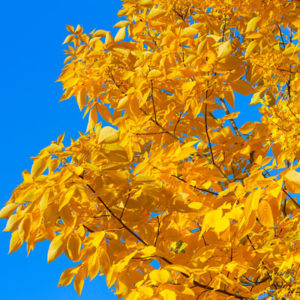 There are several types of hickory native to Virginia, including the Bitternut or Swamp Hickory, Shagbark Hickory, Pignut Hickory, and Mockernut Hickory. All reach between 50 to 80 feet in height and produce a crop of nuts each fall that is a favorite food source for wildlife (except the bitter nuts of the Bitternut Hickory, which tends to be a food of last resort).
There are several types of hickory native to Virginia, including the Bitternut or Swamp Hickory, Shagbark Hickory, Pignut Hickory, and Mockernut Hickory. All reach between 50 to 80 feet in height and produce a crop of nuts each fall that is a favorite food source for wildlife (except the bitter nuts of the Bitternut Hickory, which tends to be a food of last resort).
Hickories are another one of our native trees that turn bright yellow in fall, with the Shagbark Hickory being perhaps the best. Not only is it colorful in fall, with golden leaves that seem to glow, but it provides winter interest with its shaggy bark. Just be careful where you plant it as the nuts can come raining down on anything below it in fall.
American Hornbeam (Carpinus caroliniana)
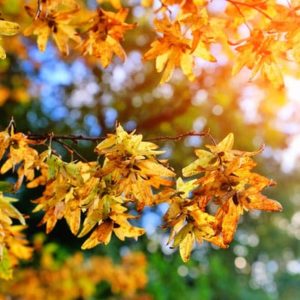 A much smaller tree compared to the others listed here, the slow-growing American hornbeam only reaches 20 to 35 feet tall at maturity (although it often tops about closer to 20 feet). But it also might reach that same width, which is what makes it a good hedge or living fence when properly pruned. It’s a terrific addition to small yards as a specimen tree and also works well in a more natural landscape.
A much smaller tree compared to the others listed here, the slow-growing American hornbeam only reaches 20 to 35 feet tall at maturity (although it often tops about closer to 20 feet). But it also might reach that same width, which is what makes it a good hedge or living fence when properly pruned. It’s a terrific addition to small yards as a specimen tree and also works well in a more natural landscape.
Hornbeam has several common names, each derived from the look of the tree. For example, it’s called Musclewood because the branches and trunk look like flexing muscles, and Ironwood because of the strength of the wood. It’s also easy to confuse with European Hornbeam (Carpinus betulus) which is often grown here and looks very much the same.
As the tree grows, the branches turn and twist, making a unique and interesting visual element in your yard or garden. It also produces seeds that are a valuable food source for birds and squirrels.
In fall, the normally blue-green leaves turn various shades of yellow and orange, sometimes with a scarlet tinge, creating a dazzling display in the landscape.
Black Walnut (Juglans nigra)
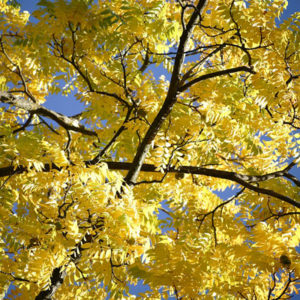 The black walnut tree is best known for its popular wood and for the walnuts it produces, but it also makes a beautiful specimen tree in the home landscape. It has a straight trunk, can reach 50-90 feet in height, and stays relatively narrow. It prefers deep, well-drained soils so wouldn’t be a good choice in a small urban yard with compacted soil.
The black walnut tree is best known for its popular wood and for the walnuts it produces, but it also makes a beautiful specimen tree in the home landscape. It has a straight trunk, can reach 50-90 feet in height, and stays relatively narrow. It prefers deep, well-drained soils so wouldn’t be a good choice in a small urban yard with compacted soil.
Aside from the fruit that matures in late summer to fall, the rich green leaves turn a brilliant yellow in fall, putting on a spectacular display.
Black walnut trees secrete a chemical called juglone, which prevents many other species from growing anywhere near them. For example, apples, tomatoes, pines, and birch are poisoned by juglone and shouldn’t be planted in proximity to a black walnut.
Planting Trees for Fall Color
All of these trees produce the best fall color when planted in full sun, so if you want to plant one this fall (this is a great time of year for planting trees!) be sure to pick a sunny location. Consider the mature size of the tree and ensure that you can give it enough water to get off to a good start. Trees under stress tend not to have great fall color, so give landscape specimens additional water during the summer heat and periods of drought (learn why leaves change color in fall).
Although they don’t all have the bright red or orange foliage you may associate with autumn, any one of these trees will make your fall landscape a little brighter.
Of course, it’s important to choose the right tree for your property and plant it in the best spot. See our tips on how and where to plant trees like the ones described in this article.
In need of tree care services?
Give us a call at 571-244-3838 or request a quote online!
More Articles From Green Vista Tree Care







